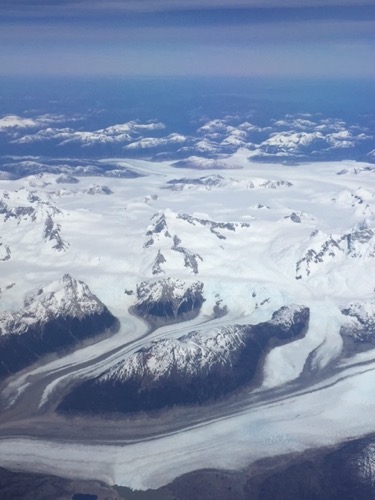The Journey Begins
Friday 10/21 marked the last day of school before Fall break, and my last day in the states before my big adventure to Punta Arenas Chile. I had assembled my needed items for months, checked my lists, bought chargers, batteries, layers, and gifts, and now it was finally time to put my bags together. Working to keep the weight below 23 kg (50 lbs) was challenging, especially without a scale on hand!
 Ready to hit the skies!
Ready to hit the skies!
I gathered together all my computer parts and camera bits, and distributed things as best I could between my bags to give myself the best chance of hitting the mark. My family drove me to the airport – it was time to go!
It's a long way to the bottom of the world
My first peak at the Andes came before sunrise as we flew south along the west coast of Chile. Our path had been almost completely straight, heading first across the Gulf of Mexico – its northern edge lit by oil rigs right off the coast, over central America, over Honduras or Costa Rica, and finding the western stretch of Peru before traversing the long profile of Chile. Very different from the Rocky Mountains, the Andes jut up suddenly and form a strong, jagged silhouette. As we continued south over Chile, the sun began to rise, showing off the rugged peaks of the long Andes mountain chain.
 Dawn breaks over the Andes
Dawn breaks over the Andes
 Flight path from Dallas to Santiago
Flight path from Dallas to Santiago
After boarding my 3rd and final flight from Santiago to Punta Arenas, we were treated to a full glorious view of Torres del Paine National Park, a 900 square mile park boasting 7,000' granite peaks, glaciers that stream down from large ice fields to fill lakes of various shades of blue.
 Glaciers stream down from a large ice field at Torres del Paine National Park, Chile
Glaciers stream down from a large ice field at Torres del Paine National Park, Chile
Traveling farther south, we crossed rivers and water carrying "glacial flour" which turns the water a milky pale blue color.
 At lower elevation, the glaciers turn to rivers, carrying glacial "flour"
At lower elevation, the glaciers turn to rivers, carrying glacial "flour"
23 hours of travel later we landed in Punta Arenas, Chile. NASA's DC-8 was prominently on display as we taxied in, striking a handsome pose. It was here on one of its "Hard Ground Days". Because there are two crews who need to keep regular hours without exceeding flight hour limits, hard ground days are scheduled in advance to keep the schedule predictable and allow the crews to rest. We hope for good weather tomorrow so we can fly, my first in the skies above Antarctica.
Science and Weather Briefing
At 1800, we all met up in the top floor of the hotel for a weather briefing and to make a plan for the next day. It turns out that after months of the western target sites being socked in with clouds, it is still not clearing. This area contains several of our "high priority" sites that the team really wants to get to, but it's probably going to have to wait another day or two. None the less, new arrivals, including myself, took part in a safety briefing, including learning about a "smoke hood" that is in a small pouch between the seats, that we need to have with us at all times as we visit instrument stations around the plane. As you can imagine, the safety concerns are a bit more severe on this flight than most, so there are a few extra things for us to learn. 


Comments